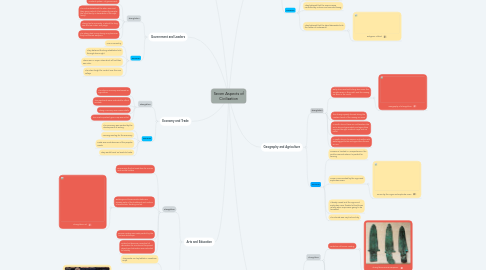
1. Social Structure and Family
1.1. Shang/Zhou
1.1.1. The social structure of the shang/zhou went in the order of ruling family, nobles, artisans and traders, farmers, then slaves
1.1.2. Nobles made weapons and fought for the king so they were very important to the ruling family
1.1.3. Artisans were crafters of jewelry, decoration, and clothing. They used the materials of bronze, jade, ceramics, stone and silk
1.1.4. Farmers were the largest of the social classes
1.2. Sumerian
1.2.1. The social structure of the Sumerians went in the order of nobles, commoners, clients and slaves.
1.2.2. The nobles included the ruling family, priests, warriors, and families that were wealthy and owned large areas of land
1.2.3. Commoners were made up of fishermen, craftsmen, and merchants
1.2.4. Men were the heads of the families and were able to have more than one wife
2. Government and Leaders
2.1. Shang/Zhou
2.1.1. "Federal System" of government.
2.1.2. The rule outstretched the Zhou area and they gave parts of it to trustworthy people, the royal family, or decedents of the royal family.
2.1.3. Shang had a monarchy. In which the king was the law maker and judge.
2.1.4. The Shang had a very strong army because they had bronze weapons.
2.2. Sumerian
2.2.1. Was a monarchy.
2.2.2. They believed the king established rule through divine right.
2.2.3. There was 12 major cities which all had their own ruler.
2.2.4. The cities fought for control over the river valleys
3. Economy and Trade
3.1. Shang/Zhou
3.1.1. The Zhou's economy was based on agriculture.
3.1.2. The merchants were restricted to offical markets.
3.1.3. Shang's currency was cowrie shells
3.1.4. The most important grain crop was millet.
3.2. Sumerian
3.2.1. The economy was assisted by the development of writing.
3.2.2. Farming was big for the economy.
3.2.3. Trade was made because of the peoples needs.
3.2.4. They would travel on boats to trade.
4. Arts and Education
4.1. Shang/Zhou
4.1.1. Bronze was the first used item for mirrors and candle holders
4.1.2. Buildings and bureaucratic states are already parts of the traditional and uniform Chinese state, thinking and art.
4.1.2.1. Shang/Zhou art
4.1.3. Bronze casting was made perfect by the lost-wax technique
4.1.4. Pictoral art became a new tool of decoration for murals and lacquered objects and education was restricted to nobility
4.2. Sumerian
4.2.1. They wrote on clay tablets in cuneiform script
4.2.2. For the Sumerians, art was mainly about supporting the relationships between people and gods, and plants and animals
4.2.2.1. Sumerian art
4.2.3. The earliest statues were made out of clay
4.2.4. The cylinder seal was a small piece of stone/clay that can be put in a purse, or can hang on a string, like a necklace
5. Religion
5.1. Shang/Zhou
5.1.1. Used the Mandate of Heaven- a system that gave the king power to rule as long as he satisfied the gods and his people
5.1.1.1. Religious Artifact
5.1.2. The people believed that the king was chosen by godly order
5.1.3. Signs that the gods weren't happy were droughts, bad storms, natural disasters etc.
5.1.4. Shang kings saw the universe filled with real ghosts and spirits of good and evil
5.2. Sumerian
5.2.1. Regarded the universe as consisting of heaven and earth
5.2.2. Earth was a flat disk surrounded by a hollow space enclosed by a solid surface they thought to be tin
5.2.3. They believed that the cosmos were controlled by a divine and immortal being
5.2.4. They believed that the dead descended into the nether of underworld
5.2.4.1. Religious Artifact
6. Geography and Agriculture
6.1. Shang/Zhou
6.1.1. Early China was built along two rivers, the Yangtze River in the South and the Hwang He River in the North
6.1.1.1. Geography of Shang/Zhou
6.1.2. The Shang Dynasty formed along the Western bend of the Hwang He River
6.1.3. In North China, there are cold winters, the soil is dry and permeable and agriculture requires drought resistant crops such as millet
6.1.4. In South China, it's warmer and wetter with waterlogged fields and agriculture thrives on rice
6.2. Sumerian
6.2.1. Sumeria is located in Mesopotamia in the Fertile Crescent where it is perfect for farming
6.2.2. Sumer is surrounded by the Tigris and Euphrates Rivers
6.2.2.1. Sumer by the Tigris and Euphrate rivers
6.2.3. It barely rained and the Tigris and Euphrates rivers flooded at bad times usually when crops were going to be harvested
6.2.4. The climate was very hot and dry
7. Science and Technology
7.1. Shang/Zhou
7.1.1. Perfection of bronze casting.
7.1.1.1. Shang/Zhou Bronze weapons.
7.1.2. Engineering technology for irrigation.
7.1.3. Perfection of the calendar.
7.1.4. Dying of yarns and silk.
7.2. Sumerian
7.2.1. 1st evidence of writing.
7.2.1.1. Sumerian writing
7.2.2. Many believe they were the 1st to invent the wheel/ pottery wheel.
7.2.3. Developed trade.
7.2.4. Invented many military formations.

